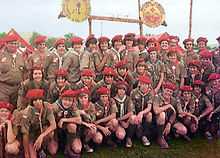Scout troop

The Scout troop is a unit of Scouts, Boy Scouts, Girl Guides and Girl Scouts that usually meet weekly. Girl Guides often use Unit or Company instead. The troop is the fundamental unit, which a Scout joins and via which he or she participates in Scouting activities, such as camping, backpacking, and canoeing. The troop leadership, youth and adult, organizes and provides support for these activities. The troop size can vary from as few as a half-dozen Scouts to several dozen. Troops work on badges and awards together, and arrange activities, events, and camping trips together.
Each troop is divided into patrols of five to ten Scouts. A patrol's independence from the troop varies among troops and between activities. For instance, a troop typically holds ordinary meetings as a unit. Patrols' autonomy becomes more visible at campouts, where each patrol may set up its own cooking area. However, on a high adventure trip which only a small part of the troop attends, divisions between patrols may disappear entirely.
In many countries a local organization called a Scout Group, combines a Scout troop with other groups of different age levels together in a single body. For example, a Beaver Scout Colony, a Cub Scout Pack, a Scout troop, a Venture Scout Crew and a Rover Scout Crew together might form a Scout Group. In other countries, the different sections are independent of each other, although they might be sponsored or chartered by the same community organisation, such as a business, service organisation, school, labor group veteran's group, or religious institution. The chartering organization is responsible for providing a meeting place and promoting a good program.
A key component of the Scout method is that troops are run by the Scouts under the advice and guidance of adult leaders. The patrol method is the most common way that scout-run troops are run, especially in Boy Scouts.[1]